For a printable version of newsletter click here.
For a printable version of newsletter with photos click here.
For a printable version of newsletter with photos click here.
Greetings from your Einkorn. And from Bere.
November comes over the Einkorn field – yes, over the field because this month contains a remoteness, the skies lower even on sunny days, late-morning cloud drifts colored a far-away light pink, an ephemeral hue, a winter omen over the field. The young Einkorn stands green in the furrows, rows of grass, grass tufts growing as robust as the shrinking temperatures allow.
You never know what November will do. Some years, autumn‘s mellow temperatures prolong, the farmer wishing for every Fahrenheit degree nature can exhale this late in the season. “Before Thanksgiving...” That’s the line in the sand winter draws for the grower. Of course, occasionally a relatively warm period will extend after that November Thursday of turkey, but the odds are darn small for that, so the feast day becomes the turning point in farmer mind.
Other years cold grips early, November descending into freeze, ice, snow, dense cold fog. Winter-grain stands then settle into their dormant phase, that long, green endurance. Deer now come up again from the coulees, herds of deer wandering about the fall-seeded cereals, always wary of coyote and human hunters, too.
What’s worst for the new fields is an abrupt temperature plummet. When the weather’s been coasting along above the freezing point, then suddenly plunges into the Fahrenheit teens, the fresh growth is overwhelmed, turns black, withers. Later in winter it can withstand much colder temps, zero and below, so it’s definitely the temperature precipice which causes the damage. After such wilt the stand will grow back up from the roots come spring, but the field then acts like a stand of spring grain, producing less yield than winter type. Thus the farmer prays for gradual temperature drops in November, he wants his young stands to slide gently into their winter endurance.
Skeins of geese draw south. The last shots of deer hunting season are heard. The graying mood of sky and land has you lift eyes to the daffodil light emanating from the farmhouse window. Steps become strides as you anticipate kitchen warmth, warmth fragrant with the coming holiday season.
Let’s leave cold winds a-blow outside and gather at the kitchen table for the tale of a different ancient grain, a cousin of Einkorn especially suited for the spell that stretches from Thanksgiving to the Advent Sundays to St Lucia’s Day and Christmas – call it Yuletide –, on to Sylvester and a Happy New Year. How quickly Thanksgiving came around again, eh. We must be getting old...
Cooking changes, baking changes in November. The frolic of summer’s gone, long gone the pleasures of fresh soft fruits and ice cream and “let’s just eat a salad tonight.” Just as we put on coat and hat to venture into the shortening daylight, so the nourishment we prepare on stove and in oven trends to hearty now.
Hearty. In terms of grain, a hearty grain for the hardy. The cereal who nurtured the strength of the pyramid builders – while their pharaohs dined on Emmer. The cereal favored by peoples in especially rough climes, such as the hardy Scots on their isles pounded by ocean’s wet fury, such as the hardy Tibetans in their high-altitude thinness of air where storms blow from the very roof of the world.
This hearty grain is Bere. Bere is an archetype of the Hordeum family we know as barley.
Wild barley was harvested in pre-agrarian times along the Nile of Egypt, 17,000 years ago. If this is indication of the Nile Valley as region of barley’s origin is uncertain, however, because the evidence is limited to a single site discovered just prior to the 1970s dam building that put a stop to archeological excavations in a broad swath of the Nile Valley. Other evidence puts barley’s origins in Anatolia, nearer Einkorn’s point of origin. In any case it’s a fact that barley took part in the first wave of domestication across the Fertile Crescent. A recent archeobotanical map (Offprints, Antiquity Publications, Sept. 2012) shows an oblong-shaped area of Einkorn radiating east and south from Karaca Dag in Kurdistan, overlapped by an also oblong area of Emmer; adjacent, an elongated area of original barley bends to the south and east, toward what’s Syria today, and Iraq.
As for barley spreading its genes, a few archeobotanical finds indicate it was raised together with Einkorn and Emmer, mostly, though, barley found its own routes, the Hordeum family traveling apart from the Triticum Farro grains.
But we’ll begin our story with barley’s place in 21st-century America.
November comes over the Einkorn field – yes, over the field because this month contains a remoteness, the skies lower even on sunny days, late-morning cloud drifts colored a far-away light pink, an ephemeral hue, a winter omen over the field. The young Einkorn stands green in the furrows, rows of grass, grass tufts growing as robust as the shrinking temperatures allow.
You never know what November will do. Some years, autumn‘s mellow temperatures prolong, the farmer wishing for every Fahrenheit degree nature can exhale this late in the season. “Before Thanksgiving...” That’s the line in the sand winter draws for the grower. Of course, occasionally a relatively warm period will extend after that November Thursday of turkey, but the odds are darn small for that, so the feast day becomes the turning point in farmer mind.
Other years cold grips early, November descending into freeze, ice, snow, dense cold fog. Winter-grain stands then settle into their dormant phase, that long, green endurance. Deer now come up again from the coulees, herds of deer wandering about the fall-seeded cereals, always wary of coyote and human hunters, too.
What’s worst for the new fields is an abrupt temperature plummet. When the weather’s been coasting along above the freezing point, then suddenly plunges into the Fahrenheit teens, the fresh growth is overwhelmed, turns black, withers. Later in winter it can withstand much colder temps, zero and below, so it’s definitely the temperature precipice which causes the damage. After such wilt the stand will grow back up from the roots come spring, but the field then acts like a stand of spring grain, producing less yield than winter type. Thus the farmer prays for gradual temperature drops in November, he wants his young stands to slide gently into their winter endurance.
Skeins of geese draw south. The last shots of deer hunting season are heard. The graying mood of sky and land has you lift eyes to the daffodil light emanating from the farmhouse window. Steps become strides as you anticipate kitchen warmth, warmth fragrant with the coming holiday season.
Let’s leave cold winds a-blow outside and gather at the kitchen table for the tale of a different ancient grain, a cousin of Einkorn especially suited for the spell that stretches from Thanksgiving to the Advent Sundays to St Lucia’s Day and Christmas – call it Yuletide –, on to Sylvester and a Happy New Year. How quickly Thanksgiving came around again, eh. We must be getting old...
Cooking changes, baking changes in November. The frolic of summer’s gone, long gone the pleasures of fresh soft fruits and ice cream and “let’s just eat a salad tonight.” Just as we put on coat and hat to venture into the shortening daylight, so the nourishment we prepare on stove and in oven trends to hearty now.
Hearty. In terms of grain, a hearty grain for the hardy. The cereal who nurtured the strength of the pyramid builders – while their pharaohs dined on Emmer. The cereal favored by peoples in especially rough climes, such as the hardy Scots on their isles pounded by ocean’s wet fury, such as the hardy Tibetans in their high-altitude thinness of air where storms blow from the very roof of the world.
This hearty grain is Bere. Bere is an archetype of the Hordeum family we know as barley.
Wild barley was harvested in pre-agrarian times along the Nile of Egypt, 17,000 years ago. If this is indication of the Nile Valley as region of barley’s origin is uncertain, however, because the evidence is limited to a single site discovered just prior to the 1970s dam building that put a stop to archeological excavations in a broad swath of the Nile Valley. Other evidence puts barley’s origins in Anatolia, nearer Einkorn’s point of origin. In any case it’s a fact that barley took part in the first wave of domestication across the Fertile Crescent. A recent archeobotanical map (Offprints, Antiquity Publications, Sept. 2012) shows an oblong-shaped area of Einkorn radiating east and south from Karaca Dag in Kurdistan, overlapped by an also oblong area of Emmer; adjacent, an elongated area of original barley bends to the south and east, toward what’s Syria today, and Iraq.
As for barley spreading its genes, a few archeobotanical finds indicate it was raised together with Einkorn and Emmer, mostly, though, barley found its own routes, the Hordeum family traveling apart from the Triticum Farro grains.
But we’ll begin our story with barley’s place in 21st-century America.
*****
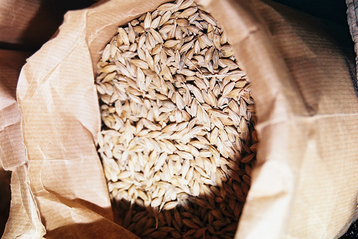
The Washington wheat industry regards barley as “the little sister of wheat.” That’s in reference to the smaller number of barley acres. Common practice was and is to interrupt successive winter wheat production when weed pressure has become intense; the spring cropping strategy counters the weed pressure built-up, since spring tillage eliminates more weeds than fall tillage does. Barley was long a popular spring-grain choice, peaking in the 1980s when Washington barley production amounted to 1.2 million acres. Since then, the markets for barley – feeds, malts, and pearled barley food product – have not kept up with wheat market price hikes, so that by 2008 the state’s barley acres had decreased to 200,000.
Like Einkorn, barley is a diploid. According to barley breeder Steve Ullrich at Washington State University, Pullman, wheat and barley are near-enough relatives to be cross-bred. "Barley chromosomes are homologous with wheat chromosomes. You can substitute wheat chromosomes with barley chromosomes, although, you cannot put wheat chromosomes into barley because there is no genetic buffering with a diploid."
Like Einkorn, barley is a diploid. According to barley breeder Steve Ullrich at Washington State University, Pullman, wheat and barley are near-enough relatives to be cross-bred. "Barley chromosomes are homologous with wheat chromosomes. You can substitute wheat chromosomes with barley chromosomes, although, you cannot put wheat chromosomes into barley because there is no genetic buffering with a diploid."
Barley has distinguished itself as "a tough crop," Ullrich noted. "It's one of the most adaptable cereal grains, it grows further up the mountains than most grains, as high as at 14,000 feet in the Andes, and it grows farther into the Sahara desert, and it grows at far-north latitudes in Scandinavia and Russia. Rye is more winter hardy, but rye never gained quite the acceptance (as food) like barley did."
Worldwide, barley rose to fourth place in agricultural production, ranking after rice, maize, wheat, but lately barley has yielded that prominence to soybeans. In the United States the decline in barley acreage was accelerated by the Conservation Reserve Program targeting acres of relatively poor soils – "the CRP took out a lot of barley" –, and by farm bill programs that "discriminate against barley and oats," Ullrich said. A further hurdle for barley production are some of the newer farm chemicals including the Clearfield-Beyond system that stipulates plant-back restrictions on barley, between six and 18 months. "That's significant in terms of barley acreage," Ullrich remarked.
Worldwide, barley rose to fourth place in agricultural production, ranking after rice, maize, wheat, but lately barley has yielded that prominence to soybeans. In the United States the decline in barley acreage was accelerated by the Conservation Reserve Program targeting acres of relatively poor soils – "the CRP took out a lot of barley" –, and by farm bill programs that "discriminate against barley and oats," Ullrich said. A further hurdle for barley production are some of the newer farm chemicals including the Clearfield-Beyond system that stipulates plant-back restrictions on barley, between six and 18 months. "That's significant in terms of barley acreage," Ullrich remarked.
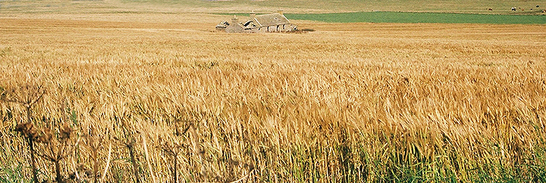
He pointed out that in the Palouse, spring barley has to make do with the "worst place in the rotation" – between winter wheat and spring peas.
End-use of barley is somewhat unique because, not counting malt, only about 2 percent to 4 percent of U.S. production goes for food.
But that percentage has begun to change, Ullrich noted. "We've known since the 1990s that the high beta-glucan content in barley assists with lowering blood cholesterol, and it reduces the glycemic index, which helps reduce risk of heart disease and diabetes."
The glycemic index measures the glucose response to consumption of foods. When carbohydrates are eaten, blood glucose is elevated, and insulin is released and rises in the blood in response to the rise in glucose. Continual high spiking of glucose is a health risk because the corresponding insulin peaks can cause insulin resistance, so a low glycemic index is desirable, that is, an attenuated rise of glucose.
According to the literature, in a study that compared porridge and breads made from wheat, from oats, and from barley, the lowest blood glucose concentrations were observed after consumption of the high-fiber barley products, specifically those high in beta-glucan soluble fiber.
The public didn't hear much about that because only recently has the FDA proclaimed barley as "heart healthy", in contrast to oats whose beta-glucan health benefits have been touted for years. "Quaker Oats was pushing for the ‘heart-healthy’ label, it's a big marketing deal. Barley didn't have a sugar-daddy like that," Ullrich quipped.
Physiologically, one difference between oats and barley is that in oats the the beta-glucan is concentrated in the bran, whereas in barley it's throughout the kernel, mostly in the endosperm, Ullrich noted.He pointed out that in the Palouse, spring barley has to make do with the "worst place in the rotation" – between winter wheat and spring peas.
End-use of barley is somewhat unique because, not counting malt, only about 2 percent to 4 percent of U.S. production goes for food.
But that percentage has begun to change, Ullrich noted. "We've known since the 1990s that the high beta-glucan content in barley assists with lowering blood cholesterol, and it reduces the glycemic index, which helps reduce risk of heart disease and diabetes."
The glycemic index measures the glucose response to consumption of foods. When carbohydrates are eaten, blood glucose is elevated, and insulin is released and rises in the blood in response to the rise in glucose. Continual high spiking of glucose is a health risk because the corresponding insulin peaks can cause insulin resistance, so a low glycemic index is desirable, that is, an attenuated rise of glucose.
According to the literature, in a study that compared porridge and breads made from wheat, from oats, and from barley, the lowest blood glucose concentrations were observed after consumption of the high-fiber barley products, specifically those high in beta-glucan soluble fiber.
The public didn't hear much about that because only recently has the FDA proclaimed barley as "heart healthy", in contrast to oats whose beta-glucan health benefits have been touted for years. "Quaker Oats was pushing for the ‘heart-healthy’ label, it's a big marketing deal. Barley didn't have a sugar-daddy like that," Ullrich quipped.
Physiologically, one difference between oats and barley is that in oats the the beta-glucan is concentrated in the bran, whereas in barley it's throughout the kernel, mostly in the endosperm, Ullrich noted.
End-use of barley is somewhat unique because, not counting malt, only about 2 percent to 4 percent of U.S. production goes for food.
But that percentage has begun to change, Ullrich noted. "We've known since the 1990s that the high beta-glucan content in barley assists with lowering blood cholesterol, and it reduces the glycemic index, which helps reduce risk of heart disease and diabetes."
The glycemic index measures the glucose response to consumption of foods. When carbohydrates are eaten, blood glucose is elevated, and insulin is released and rises in the blood in response to the rise in glucose. Continual high spiking of glucose is a health risk because the corresponding insulin peaks can cause insulin resistance, so a low glycemic index is desirable, that is, an attenuated rise of glucose.
According to the literature, in a study that compared porridge and breads made from wheat, from oats, and from barley, the lowest blood glucose concentrations were observed after consumption of the high-fiber barley products, specifically those high in beta-glucan soluble fiber.
The public didn't hear much about that because only recently has the FDA proclaimed barley as "heart healthy", in contrast to oats whose beta-glucan health benefits have been touted for years. "Quaker Oats was pushing for the ‘heart-healthy’ label, it's a big marketing deal. Barley didn't have a sugar-daddy like that," Ullrich quipped.
Physiologically, one difference between oats and barley is that in oats the the beta-glucan is concentrated in the bran, whereas in barley it's throughout the kernel, mostly in the endosperm, Ullrich noted.He pointed out that in the Palouse, spring barley has to make do with the "worst place in the rotation" – between winter wheat and spring peas.
End-use of barley is somewhat unique because, not counting malt, only about 2 percent to 4 percent of U.S. production goes for food.
But that percentage has begun to change, Ullrich noted. "We've known since the 1990s that the high beta-glucan content in barley assists with lowering blood cholesterol, and it reduces the glycemic index, which helps reduce risk of heart disease and diabetes."
The glycemic index measures the glucose response to consumption of foods. When carbohydrates are eaten, blood glucose is elevated, and insulin is released and rises in the blood in response to the rise in glucose. Continual high spiking of glucose is a health risk because the corresponding insulin peaks can cause insulin resistance, so a low glycemic index is desirable, that is, an attenuated rise of glucose.
According to the literature, in a study that compared porridge and breads made from wheat, from oats, and from barley, the lowest blood glucose concentrations were observed after consumption of the high-fiber barley products, specifically those high in beta-glucan soluble fiber.
The public didn't hear much about that because only recently has the FDA proclaimed barley as "heart healthy", in contrast to oats whose beta-glucan health benefits have been touted for years. "Quaker Oats was pushing for the ‘heart-healthy’ label, it's a big marketing deal. Barley didn't have a sugar-daddy like that," Ullrich quipped.
Physiologically, one difference between oats and barley is that in oats the the beta-glucan is concentrated in the bran, whereas in barley it's throughout the kernel, mostly in the endosperm, Ullrich noted.
*****
If American barley as food product is likely to gain market share due to the grain’s health benefits, it will be a long time before barley grocery sales match barley use in malting. Think of all the beer, cheers!, and follow us to Great Western Malting in Vancouver, Washington.
The Great Western facility announces its commodity grain scale by sheer size; its concrete structures square and vertically flat express the industrialism emblematic of 1930s Washington when the Northwest quaffed Blitz, Heidelberg, Lucky, Olympia, which breweries had joint-ventured to start up this malting company.
Jay Hamachek, director of Business Development at Great Western, will take us on a tour. But first he gives us a run-down of trends in the malting industry.
Since 1989 Great Western has seen several changes in ownership. Today its umbrella organization is United Malt Holdings who also own Barrett Burston Malting, Australia and Bairds Malt, Great Britain and, Canada Malting with plants in Quebec, Ontario and Alberta. In addition to malt plants, UMH North America operate grain elevators, warehouse and bagging facilities, and they have a container-designated site in Vancouver, British Columbia.
Great Western has taken on equity partners as well, CHAMP Private Equity and Castel Harlan Inc. In Vancouver and at their Pocatello, Idaho malting plants, Great Western now produce a whopping 239,000 metric tons of malt a year, 75 percent of which they sell domestically.
There are many uses for malt, malt features in breakfast cereals, and bakers use barley malt flours for pretzels and some breads. "But here we stick with the noble tradition of making malt for beer," Hamachek noted.
If barley malt ties to the brewing trade, a venerable trade that is, Hamachek pointed out: "One of the first written recipes in the Sumerian era, dated about 3500 B.C., describes how to make beer. Making malt today is basically the same process."
In colonial America hard ciders were the drink of choice, as in Britain where laborers were sometimes paid in cider for their toil. Switching from hard cider to beer was taken as a statement of independence from the English King in the early days of America. And then all those Central Europeans immigrated from places like Pilsen and Munich where beer had long been an important part of the culture – beer became America’s beverage of choice.
In the 20th century the shift was to mass markets. "The malt houses are bigger than they were in the past. Today the maltsters have better capabilities to control the malting process."
The microbrew trend that sprouted in the 1970s has developed into quite a little industry, Hamachek said. American beer consumption on the whole is growing at a slow 2 percent, whereas the annual growth of craft brews registers at a robust 12 percent. "The growth in craft brews is almost like the Starbucks phenomenon," Hamachek commented. "More and more people are willing to pay for quality and uniqueness."
The microbrew trend has added to Great Western’s shipping logistics; whereas most malt leaves the plant in bulk by truck, rail, or container, bagged malt reaches craft brewers through a "food service type" channeling system.
Globally the rise in beer drinking tracks a strong curve upward, from 1340-million hectoliters (1 hectoliter = 100 liters = 26.418 gallons) consumed in 1998, to 1680-million hectoliters in 2006, with over 2000-million hectoliters consumption forecast for 2015. The lion's share of this beer consumption increase occurs in Asia where the world's largest beer producer is located: China brews an astonishing 352-million hectoliters a year, of which 323-million hectoliters are drunk domestically. The highest per capita beer consumption is in the Czech Republic, 157 liters of beer a year per person, although projections indicate a decline in beer drinking for the Czechs as well as for Germans, Brits and Canadians in the next few years.
Hamachek emphasized how important the beer industry is to maltsters: "It takes 40 pounds of malt for every (31-gallon) beer barrel." That's in contrast to the hop ingredient , of hop there are only ounces per barrel.
The Great Western facility announces its commodity grain scale by sheer size; its concrete structures square and vertically flat express the industrialism emblematic of 1930s Washington when the Northwest quaffed Blitz, Heidelberg, Lucky, Olympia, which breweries had joint-ventured to start up this malting company.
Jay Hamachek, director of Business Development at Great Western, will take us on a tour. But first he gives us a run-down of trends in the malting industry.
Since 1989 Great Western has seen several changes in ownership. Today its umbrella organization is United Malt Holdings who also own Barrett Burston Malting, Australia and Bairds Malt, Great Britain and, Canada Malting with plants in Quebec, Ontario and Alberta. In addition to malt plants, UMH North America operate grain elevators, warehouse and bagging facilities, and they have a container-designated site in Vancouver, British Columbia.
Great Western has taken on equity partners as well, CHAMP Private Equity and Castel Harlan Inc. In Vancouver and at their Pocatello, Idaho malting plants, Great Western now produce a whopping 239,000 metric tons of malt a year, 75 percent of which they sell domestically.
There are many uses for malt, malt features in breakfast cereals, and bakers use barley malt flours for pretzels and some breads. "But here we stick with the noble tradition of making malt for beer," Hamachek noted.
If barley malt ties to the brewing trade, a venerable trade that is, Hamachek pointed out: "One of the first written recipes in the Sumerian era, dated about 3500 B.C., describes how to make beer. Making malt today is basically the same process."
In colonial America hard ciders were the drink of choice, as in Britain where laborers were sometimes paid in cider for their toil. Switching from hard cider to beer was taken as a statement of independence from the English King in the early days of America. And then all those Central Europeans immigrated from places like Pilsen and Munich where beer had long been an important part of the culture – beer became America’s beverage of choice.
In the 20th century the shift was to mass markets. "The malt houses are bigger than they were in the past. Today the maltsters have better capabilities to control the malting process."
The microbrew trend that sprouted in the 1970s has developed into quite a little industry, Hamachek said. American beer consumption on the whole is growing at a slow 2 percent, whereas the annual growth of craft brews registers at a robust 12 percent. "The growth in craft brews is almost like the Starbucks phenomenon," Hamachek commented. "More and more people are willing to pay for quality and uniqueness."
The microbrew trend has added to Great Western’s shipping logistics; whereas most malt leaves the plant in bulk by truck, rail, or container, bagged malt reaches craft brewers through a "food service type" channeling system.
Globally the rise in beer drinking tracks a strong curve upward, from 1340-million hectoliters (1 hectoliter = 100 liters = 26.418 gallons) consumed in 1998, to 1680-million hectoliters in 2006, with over 2000-million hectoliters consumption forecast for 2015. The lion's share of this beer consumption increase occurs in Asia where the world's largest beer producer is located: China brews an astonishing 352-million hectoliters a year, of which 323-million hectoliters are drunk domestically. The highest per capita beer consumption is in the Czech Republic, 157 liters of beer a year per person, although projections indicate a decline in beer drinking for the Czechs as well as for Germans, Brits and Canadians in the next few years.
Hamachek emphasized how important the beer industry is to maltsters: "It takes 40 pounds of malt for every (31-gallon) beer barrel." That's in contrast to the hop ingredient , of hop there are only ounces per barrel.
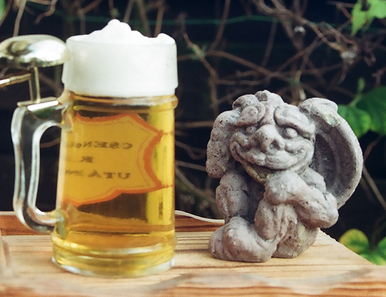
Hamachek brought to the interview a display of little jars each containing a different malt. Up front stood the common barley malts, the kilned kind, and also roasted malts. Only two maltsters in the United States offer roasted malt, he remarked. "Roasting caramelizes the malt; roasted malt adds color and flavor to the beer. A lot of roasted malt goes for porter or stout, it adds that 'charcoaly' taste and 'depth' to those beers."
Other malts are of different grains. "We've malted rye and triticale, we've even tried malting millet. And we malt wheat. For wheat malt we use the (soft white wheat) variety Madsen. If you have a wheat beer, chances are that the malt came from here."
But barley far surpasses any other malt type in demand. "Because barley (grain) has a hull it’s also the main filtration component brewers use," Hamachek noted.
On the procurement side a number of barley varieties are in demand for malting. "Some commercial companies have private barley varieties, Coors, for example, has a Moravian barley that's patented. Here we rely on university breeding programs. The breeders have been great partners over the years."
As for new barley cultivar development by university and private breeders, Hamachek is mindful of consumer perception: "From our perspective it's a good thing that there is no GMO (genetically modified organism) barley material out there," he emphasized.
Regional differences in barley are par for the course, what with plump kernels desirable while smut and ergot are unacceptable. "The barley that's grown out West presents much better," Hamachek said. Western production is also more reliable: "The Midwest has one climate model, some years the corn there needs snorkels to live. In the West the mountain ranges separate various climates."
For the tour of the malt house Hamachek handed us a hard hat. Malting is a three-step process, first cereal grain is steeped, then prompted to germinate, and then it's dried either by kilning or roasting.
That doesn’t sound all that complicated, does it? What impresses at Great Western is that these processes are applied in industrial strength. Tons and tons of grain, grain in railroad-car increments are the incoming product. The malt house felt like an over-sized hollow castle as we climbed up and up in the echoing stairwell, a heavy metal door on each floor leading to – what?, dark dungeons?
On a floor up high we see enormous vats – "steep tanks" – that receive the incoming barley. The water is oxygenated; the carbon dioxide gets drawn off at the bottom of the vat, Hamachek explained. The about two-day steeping phase includes time for the moist grain to rest in tanks without water, "couching" is the term for that.
"Every maltster has their own way to steep," Hamachek noted on the way down to the floor with the "germinating boxes." Those are bowling-alley-size rectangular structures filled with wet barley, barley five feet deep that’s being turned slowly by a contraption that moves on rails, straddling the box. "We stop germination when about 10 percent of the barley sprouts are showing," Hamachek said.
Sprouting is essential because as the kernel swells, enzymes form that are specific to the brewing process. It's due to those enzymes that kilning the "green-malt" has to be a precise science, since enzymes are easily destroyed by heat. Two floors are devoted to kilning. In the upper one – called the "withering floor" – the temperature starts out at 135 degrees Fahrenheit and slowly increases to 165 degrees. "The moisture (of the green-malt) is reduced from 46 percent to 12 percent."
The bottom of the withering floor consists of large automated slats. We climb down another story to the "curing floor." Hamachek chuckled: "You don't want to be in here when the slats above open and the malt is dropping – that's 280,000 pounds of malt coming down at once." He explained that the forced-air temperature of 185 degrees here reduces the moisture of the malt to 4 percent.
Next, Hamachek showed us the blowers integral to the complex system of moving airs, masses of fresh air and withering air and curing air and waste air and cooling air and exhaust air, a concert of artificial winds supplying the various floors, each with its own precise degree of temperature.
The roast happens in another building in big round tubs, big paddles stirring the roasted malt during the cooling-down process. In the computer room the roasters monitor the roasting processes on the screens, nevertheless, samples are taken by hand and evaluated by mouth feel, Hamachek said. "Our roasters make the call on the final product."
After the tour we met Kevin Anderson, grain manager at Great Western. Anderson related that he started with Great Western in the late 1970s; in the 1980s he worked as their fieldman out of an office in Moses Lake. He still interacts with growers in some areas including southern Oregon and Colorado, albeit over the phone. "We do have two fieldmen in southern Idaho," he notes. "They work with farmers in Idaho and Montana."
Great Western contracts with grain companies and co-ops who, in turn, contract with individual farmers. "We start contracting in the fall after we've worked out with our customers what the demand is going to be," Anderson said. "Usually our contracting period runs from November to February." Farmer contracts are by metric ton, the specs include protein and moisture, both at 12.5 percent maximum. "And the grain has to be food grade, the grower has to set his combine so the barley comes in clean and with the hull intact, because an intact hull protects the germ."
We came away from our visit to Great Western with a split sense of wonderment: we recognized in malt for beer a food preparation so ancient that its beginnings entwine with the genesis of cereal domestication, while the sheer scale of what it takes to bring brew to every grocery and gas station and tavern in the country is massive to an almost menacing degree, malt the ingredient emanating from a web of breeders, farmers, fieldmen, maltsters. And, imagine all the transportation...
We must mention that Great Western is located within the Port of Vancouver. Since 9/11, like in all Ports, security measures are intense, with gates and sentry stations and barriers constituting a maze. This makes the barley malt here perhaps the best-guarded grain in the world.
Other malts are of different grains. "We've malted rye and triticale, we've even tried malting millet. And we malt wheat. For wheat malt we use the (soft white wheat) variety Madsen. If you have a wheat beer, chances are that the malt came from here."
But barley far surpasses any other malt type in demand. "Because barley (grain) has a hull it’s also the main filtration component brewers use," Hamachek noted.
On the procurement side a number of barley varieties are in demand for malting. "Some commercial companies have private barley varieties, Coors, for example, has a Moravian barley that's patented. Here we rely on university breeding programs. The breeders have been great partners over the years."
As for new barley cultivar development by university and private breeders, Hamachek is mindful of consumer perception: "From our perspective it's a good thing that there is no GMO (genetically modified organism) barley material out there," he emphasized.
Regional differences in barley are par for the course, what with plump kernels desirable while smut and ergot are unacceptable. "The barley that's grown out West presents much better," Hamachek said. Western production is also more reliable: "The Midwest has one climate model, some years the corn there needs snorkels to live. In the West the mountain ranges separate various climates."
For the tour of the malt house Hamachek handed us a hard hat. Malting is a three-step process, first cereal grain is steeped, then prompted to germinate, and then it's dried either by kilning or roasting.
That doesn’t sound all that complicated, does it? What impresses at Great Western is that these processes are applied in industrial strength. Tons and tons of grain, grain in railroad-car increments are the incoming product. The malt house felt like an over-sized hollow castle as we climbed up and up in the echoing stairwell, a heavy metal door on each floor leading to – what?, dark dungeons?
On a floor up high we see enormous vats – "steep tanks" – that receive the incoming barley. The water is oxygenated; the carbon dioxide gets drawn off at the bottom of the vat, Hamachek explained. The about two-day steeping phase includes time for the moist grain to rest in tanks without water, "couching" is the term for that.
"Every maltster has their own way to steep," Hamachek noted on the way down to the floor with the "germinating boxes." Those are bowling-alley-size rectangular structures filled with wet barley, barley five feet deep that’s being turned slowly by a contraption that moves on rails, straddling the box. "We stop germination when about 10 percent of the barley sprouts are showing," Hamachek said.
Sprouting is essential because as the kernel swells, enzymes form that are specific to the brewing process. It's due to those enzymes that kilning the "green-malt" has to be a precise science, since enzymes are easily destroyed by heat. Two floors are devoted to kilning. In the upper one – called the "withering floor" – the temperature starts out at 135 degrees Fahrenheit and slowly increases to 165 degrees. "The moisture (of the green-malt) is reduced from 46 percent to 12 percent."
The bottom of the withering floor consists of large automated slats. We climb down another story to the "curing floor." Hamachek chuckled: "You don't want to be in here when the slats above open and the malt is dropping – that's 280,000 pounds of malt coming down at once." He explained that the forced-air temperature of 185 degrees here reduces the moisture of the malt to 4 percent.
Next, Hamachek showed us the blowers integral to the complex system of moving airs, masses of fresh air and withering air and curing air and waste air and cooling air and exhaust air, a concert of artificial winds supplying the various floors, each with its own precise degree of temperature.
The roast happens in another building in big round tubs, big paddles stirring the roasted malt during the cooling-down process. In the computer room the roasters monitor the roasting processes on the screens, nevertheless, samples are taken by hand and evaluated by mouth feel, Hamachek said. "Our roasters make the call on the final product."
After the tour we met Kevin Anderson, grain manager at Great Western. Anderson related that he started with Great Western in the late 1970s; in the 1980s he worked as their fieldman out of an office in Moses Lake. He still interacts with growers in some areas including southern Oregon and Colorado, albeit over the phone. "We do have two fieldmen in southern Idaho," he notes. "They work with farmers in Idaho and Montana."
Great Western contracts with grain companies and co-ops who, in turn, contract with individual farmers. "We start contracting in the fall after we've worked out with our customers what the demand is going to be," Anderson said. "Usually our contracting period runs from November to February." Farmer contracts are by metric ton, the specs include protein and moisture, both at 12.5 percent maximum. "And the grain has to be food grade, the grower has to set his combine so the barley comes in clean and with the hull intact, because an intact hull protects the germ."
We came away from our visit to Great Western with a split sense of wonderment: we recognized in malt for beer a food preparation so ancient that its beginnings entwine with the genesis of cereal domestication, while the sheer scale of what it takes to bring brew to every grocery and gas station and tavern in the country is massive to an almost menacing degree, malt the ingredient emanating from a web of breeders, farmers, fieldmen, maltsters. And, imagine all the transportation...
We must mention that Great Western is located within the Port of Vancouver. Since 9/11, like in all Ports, security measures are intense, with gates and sentry stations and barriers constituting a maze. This makes the barley malt here perhaps the best-guarded grain in the world.
*****
All the barley talk at Great Western revolved around what’s termed “hulled” barley, which is understandable because brewers use the hulls as convenient filtration agent. Three basic variations of hulled barley exist, two-row, four-row and six-row, each named after its particular spikelet alignment on the grain head.
But when the original barley was first domesticated, it appeared as two types: one called hulless, the hulls of which separate at threshing almost as easily as the later-occurring “free-threshing” wheat; the other was the hulled type barley. In hulled barley a cementing substance that binds the hull to the kernel appears 16 days after pollination.
Why are the hulless barleys almost unknown in America? Chalk it up to industrialization’s relentless focus on high output: hulless barleys yield less than hulled barleys.
The cement-like substance of hulled barley makes it impossible to dehull the barley as one can dehull the Farro grains. The only way to make a food product out of American barleys is to grind that hull away, in a process called pearling.
To get the scoop on the pearled barley you see modestly positioned on the shelf among dry beans, lentils, rices, we traverse the state to the city of Palouse, home of Palouse Grain Growers. Their barley pearling plant is the only such facility in Washington. As manager of the co-op, Bruce Baldwin’s job description expanded greatly after the co-op purchased the pearling plant in 2000.
Baldwin mans the downtown office of the co-op by himself. "The co-op has 56 members, 21 are active farmers. The crops are raised in a five-mile radius,” he told us. “The pearling plant is now running 12 to 14 hours, six to seven days a week, year-round."
In the office diverse pearled barleys are on display. “Pearling dehulls the barley and, beyond that, polishes it.” Differences in the degree of pearling account for the product differences, Baldwin said.
The "coarse grind" takes off most of the hull; this barley is a robust food sometimes called "pot" or "Scotch" barley. Much of their coarse grind leaves by hopper-bottom semi-truck, destined for pet food manufacture, Baldwin noted.
The "regular" or "medium grind" removes more of the barley hull. "That's the grind you see in packages at grocery stores."
The "fine grind" removes all of the hull except for a barely visible streak in the crease of the kernel, Baldwin explained. "That's the grind that's used in the canned soups you buy in stores, and in soups pre-made for restaurants."
Finally, the "super-fine grind" is the lightest color, for specialty products. "When you grind off that much you break a lot of kernels, you're polishing a lot of half-kernels."
One sample on display has another origin. "That's imported barley," Baldwin said. "Back East they really like that bright white color, but we can't produce it here. We can seed the variety, but the kernels don't get that color here in our region."
Naturally, the more you grind, the more the incoming weight shrinks. On coarse grind it takes 120 pounds of barley to produce a hundredweight pearled; on super-fine grind it takes 160 pounds for 100 pounds pearled, Baldwin noted.
Nicely enough, except for a little chaff and a few stones that sneak in from the field, there is no real weight loss in their pearling process, Baldwin stressed. "We run all the by-product material through a pellet mill. We sell the pellets as high-value livestock feed."
We were invited to tour the plant. As Baldwin opened the door, a big whiff rushed out, an overwhelming aroma, yet this essence of barley is quite a pleasant olfactory sensation, actually. Stepping inside, machinery noise engulfs one's ears.
From grain bins outside, the barley first flows across a "scalper", a cleaner mill consisting of screens and forced air. Next in line shakes a de-stoner gravity deck. Sticks and stones removed, the barley then gets ground between large horizontal stones – one moving, one stationary – of two rice de-hullers converted to the pearling process. After that initial grind the barley flows into two pearlers with rotating grind stones vertically stacked, surrounded by screen. Last in line is another scalper, for sizing.
The plant is definitely impressive. From polished-cement floor to high ceilings, the space is virtually dustless, so efficient is their aspiration system. All machines are enclosed to assure a safe working environment. Each production phase has its own hopper enthroned, enabling even grain flow throughout the process. On the open floor queues of 2000-pound totes wait for transport.
As for marketing the pearled barley, that’s made Baldwin keenly aware of "the soup season." Soup processing accounts for the largest use in the food category of barley, traditionally, he explained.
The co-op’s marketing strategy still relies on the 20th-century paradigm that whiter food is better food. In fact, they’ve taken a genetic approach to whiten their barley, by way of a variety called Radiant. Whereas much acreage is still planted to Baroness and Bob, the two stand-by varieties in recent years, Radiant stands out as a specialty barley.
The new cultivar has a special connection to Palouse, in that Judy Cochran, wife of local farmer Glen Cochran, made the cross and shepherded it to variety release in a 15-year breeding process at Washington State University, Pullman, working as technician under WSU barley breeder Steve Ullrich.
"I started working on Radiant in 1983," Cochran said in a telephone interview. Initially, Carlsberg Brewing of Denmark had provided the funding for the WSU barley program to develop a barley cultivar with reduced phenolic levels. "The idea for the project was conceived by Dieter von Wettstein, who at the time was research director at Carlsberg."
Why would brewers want less phenolics in their barley? In the brewing process the grain proteins precipitate out and combine with the phenol proanthocyanidin; the resulting compound has to be filtered out, Cochran explained. "A barley free of proanthocyanidin – 'proant-free' barley, for short – would eliminate that step of filtering at the brewery."
A mutant strain of barley had been found that fit the bill. "I incorporated the mutant into varieties agronomically suitable for this area," Cochran elaborated. "I made hundreds and hundreds of crosses before we finally got the cross we wanted."
By then the brewers had lost interest, however. "The brewing industry decided not to pursue the project. The issue was that raw hops also contain the phenol, so the breweries would have to change from using raw hops to using hop extract, and they didn't want to do that," she recalled.
Enter food scientist Byung-Kee Baik who was also at WSU at the time. "He determined that our cross was more appealing visually than the other barley varieties. When you cook Radiant side-by-side with other barley, the Radiant is distinctly whiter, no question," Cochran said.
Baik projected that Radiant's whiteness would be an advantage for Asian export: "Asians use barley flour for noodles, and they like their noodles white," Cochran noted, adding that she saw local potential as well. "I realized that with the pearling industry right here in Palouse, Radiant might be an advantage for us in the American food sector."
But when the original barley was first domesticated, it appeared as two types: one called hulless, the hulls of which separate at threshing almost as easily as the later-occurring “free-threshing” wheat; the other was the hulled type barley. In hulled barley a cementing substance that binds the hull to the kernel appears 16 days after pollination.
Why are the hulless barleys almost unknown in America? Chalk it up to industrialization’s relentless focus on high output: hulless barleys yield less than hulled barleys.
The cement-like substance of hulled barley makes it impossible to dehull the barley as one can dehull the Farro grains. The only way to make a food product out of American barleys is to grind that hull away, in a process called pearling.
To get the scoop on the pearled barley you see modestly positioned on the shelf among dry beans, lentils, rices, we traverse the state to the city of Palouse, home of Palouse Grain Growers. Their barley pearling plant is the only such facility in Washington. As manager of the co-op, Bruce Baldwin’s job description expanded greatly after the co-op purchased the pearling plant in 2000.
Baldwin mans the downtown office of the co-op by himself. "The co-op has 56 members, 21 are active farmers. The crops are raised in a five-mile radius,” he told us. “The pearling plant is now running 12 to 14 hours, six to seven days a week, year-round."
In the office diverse pearled barleys are on display. “Pearling dehulls the barley and, beyond that, polishes it.” Differences in the degree of pearling account for the product differences, Baldwin said.
The "coarse grind" takes off most of the hull; this barley is a robust food sometimes called "pot" or "Scotch" barley. Much of their coarse grind leaves by hopper-bottom semi-truck, destined for pet food manufacture, Baldwin noted.
The "regular" or "medium grind" removes more of the barley hull. "That's the grind you see in packages at grocery stores."
The "fine grind" removes all of the hull except for a barely visible streak in the crease of the kernel, Baldwin explained. "That's the grind that's used in the canned soups you buy in stores, and in soups pre-made for restaurants."
Finally, the "super-fine grind" is the lightest color, for specialty products. "When you grind off that much you break a lot of kernels, you're polishing a lot of half-kernels."
One sample on display has another origin. "That's imported barley," Baldwin said. "Back East they really like that bright white color, but we can't produce it here. We can seed the variety, but the kernels don't get that color here in our region."
Naturally, the more you grind, the more the incoming weight shrinks. On coarse grind it takes 120 pounds of barley to produce a hundredweight pearled; on super-fine grind it takes 160 pounds for 100 pounds pearled, Baldwin noted.
Nicely enough, except for a little chaff and a few stones that sneak in from the field, there is no real weight loss in their pearling process, Baldwin stressed. "We run all the by-product material through a pellet mill. We sell the pellets as high-value livestock feed."
We were invited to tour the plant. As Baldwin opened the door, a big whiff rushed out, an overwhelming aroma, yet this essence of barley is quite a pleasant olfactory sensation, actually. Stepping inside, machinery noise engulfs one's ears.
From grain bins outside, the barley first flows across a "scalper", a cleaner mill consisting of screens and forced air. Next in line shakes a de-stoner gravity deck. Sticks and stones removed, the barley then gets ground between large horizontal stones – one moving, one stationary – of two rice de-hullers converted to the pearling process. After that initial grind the barley flows into two pearlers with rotating grind stones vertically stacked, surrounded by screen. Last in line is another scalper, for sizing.
The plant is definitely impressive. From polished-cement floor to high ceilings, the space is virtually dustless, so efficient is their aspiration system. All machines are enclosed to assure a safe working environment. Each production phase has its own hopper enthroned, enabling even grain flow throughout the process. On the open floor queues of 2000-pound totes wait for transport.
As for marketing the pearled barley, that’s made Baldwin keenly aware of "the soup season." Soup processing accounts for the largest use in the food category of barley, traditionally, he explained.
The co-op’s marketing strategy still relies on the 20th-century paradigm that whiter food is better food. In fact, they’ve taken a genetic approach to whiten their barley, by way of a variety called Radiant. Whereas much acreage is still planted to Baroness and Bob, the two stand-by varieties in recent years, Radiant stands out as a specialty barley.
The new cultivar has a special connection to Palouse, in that Judy Cochran, wife of local farmer Glen Cochran, made the cross and shepherded it to variety release in a 15-year breeding process at Washington State University, Pullman, working as technician under WSU barley breeder Steve Ullrich.
"I started working on Radiant in 1983," Cochran said in a telephone interview. Initially, Carlsberg Brewing of Denmark had provided the funding for the WSU barley program to develop a barley cultivar with reduced phenolic levels. "The idea for the project was conceived by Dieter von Wettstein, who at the time was research director at Carlsberg."
Why would brewers want less phenolics in their barley? In the brewing process the grain proteins precipitate out and combine with the phenol proanthocyanidin; the resulting compound has to be filtered out, Cochran explained. "A barley free of proanthocyanidin – 'proant-free' barley, for short – would eliminate that step of filtering at the brewery."
A mutant strain of barley had been found that fit the bill. "I incorporated the mutant into varieties agronomically suitable for this area," Cochran elaborated. "I made hundreds and hundreds of crosses before we finally got the cross we wanted."
By then the brewers had lost interest, however. "The brewing industry decided not to pursue the project. The issue was that raw hops also contain the phenol, so the breweries would have to change from using raw hops to using hop extract, and they didn't want to do that," she recalled.
Enter food scientist Byung-Kee Baik who was also at WSU at the time. "He determined that our cross was more appealing visually than the other barley varieties. When you cook Radiant side-by-side with other barley, the Radiant is distinctly whiter, no question," Cochran said.
Baik projected that Radiant's whiteness would be an advantage for Asian export: "Asians use barley flour for noodles, and they like their noodles white," Cochran noted, adding that she saw local potential as well. "I realized that with the pearling industry right here in Palouse, Radiant might be an advantage for us in the American food sector."
*****
Take a breath. We’ve done our little tour of America’s barley industry, and found it Big and White.
Now it’s time we engage with archetype barleys. With barleys that nomads selected from wild populations among whom non-shattering subpopulations occurred just at the time when climate swings, drastic glacial-age climate swings, affected those hunter-gatherers‘ food supply. Thus the original barley, too, would take its place as a founding crop at the advent of first agriculture in the Fertile Crescent.
By the time the archetype barleys reached central Europe, the hulless genotypes were prevalent.
We must keep in mind that different preconditions existed north of the Alps than in the Fertile Crescent and around the Mediterranean. Most consequential were the great forests of what the Romans later called Germania.
Having to clear Germania’s woods to propagate the founding crops meant that the spread of Anatolia’s cereals and legumes and oil seed went hand-in-hand with the establishment of first settlements. So here, in central Europe, the old model of humans stepping from hunter-gatherer culture directly into agriculture applies, without an interim period of nomads domesticating and propagating the crops. For central Europe, archeologists imagine a mixing of cultures, supposing that both, agrarian skills from points east and south, as well as a knowledge of arboreal conditions locally, were prerequisites for growing crops.
Also significant were the glaciers’ legacy of fertile loess deposits. And, the longer summer daylight at northern latitudes means more photosynthesis and therefore faster plant growth. These two botanical advantages, taken together with the forest’s moderating effect on microclimates, made for a very different cultural development than what took place in the Fertile Crescent and around the Mediterranean. There, crop failures due to inclement weather were more likely, so once the first city-states had been established, a system that produced surplus had to be organized to assure enough food in the lean years. Further, as the populations of these city-states grew, agriculture had to expand to lands that needed to be irrigated for cropping. For these reasons, agriculture became a matter of social organization reliant on an upper class who directed agricultural activities to an efficient end. Early records have hundreds of workers – slaves, probably – toiling in a field.
Conversely, central Europe’s first farmers required much less organization. The very early settlements here were independent entities, no city-states formed. Typically these first villages were located at the edge of the loess deposits, above a river bottom where, due to rocky ground, no crops were raised but where the land was used for grazing. Immediately behind the village stretched the fields on loess that in turn bordered on the forest beyond.
There is an idyllic quality to this early, independent agrarianism, so archeologists are baffled that many of these villages were left behind at some point in time: excavations reveal only one layer.
The grains discovered at the earliest central European archeological digs point to a surprisingly high percentage of free-threshing wheats and hulless barleys. Surprising, because cereals of the hulled type are much better suited to primitive grain storage technology, naked grains rather more susceptible to mold and insect damage than grains stored in-hull. The prevailing hypothesis is that the free-threshing and hulless cereals were stored with their grain heads intact, the kernel still within their hulls. They were threshed only right before use.
Curiously, after a long period when free-threshing wheats were common, a reversal to the hulled grains occurred just north of the Alps; in particular, Triticum spelta became predominant. This leads some scientists to speculate that Spelt had a second origin: yes, the very first Spelt clearly hails from Transcaucasian lands where Emmer and Aegilops crossed; however, a second origin could have been somewhere in Europe when Emmer re-crossed with hexaploid wheat which, after all, also contains the Aegilops genes.
But back to barley. By various routes the original hulled barley also reached northern Europe. In at least one case, Scotland and its isles, the archetype hulled barely became the primary staple food. To distinguish it from more recent barleys, Scots still call the archetype Bere (pronounced like “bear”).
Now it’s time we engage with archetype barleys. With barleys that nomads selected from wild populations among whom non-shattering subpopulations occurred just at the time when climate swings, drastic glacial-age climate swings, affected those hunter-gatherers‘ food supply. Thus the original barley, too, would take its place as a founding crop at the advent of first agriculture in the Fertile Crescent.
By the time the archetype barleys reached central Europe, the hulless genotypes were prevalent.
We must keep in mind that different preconditions existed north of the Alps than in the Fertile Crescent and around the Mediterranean. Most consequential were the great forests of what the Romans later called Germania.
Having to clear Germania’s woods to propagate the founding crops meant that the spread of Anatolia’s cereals and legumes and oil seed went hand-in-hand with the establishment of first settlements. So here, in central Europe, the old model of humans stepping from hunter-gatherer culture directly into agriculture applies, without an interim period of nomads domesticating and propagating the crops. For central Europe, archeologists imagine a mixing of cultures, supposing that both, agrarian skills from points east and south, as well as a knowledge of arboreal conditions locally, were prerequisites for growing crops.
Also significant were the glaciers’ legacy of fertile loess deposits. And, the longer summer daylight at northern latitudes means more photosynthesis and therefore faster plant growth. These two botanical advantages, taken together with the forest’s moderating effect on microclimates, made for a very different cultural development than what took place in the Fertile Crescent and around the Mediterranean. There, crop failures due to inclement weather were more likely, so once the first city-states had been established, a system that produced surplus had to be organized to assure enough food in the lean years. Further, as the populations of these city-states grew, agriculture had to expand to lands that needed to be irrigated for cropping. For these reasons, agriculture became a matter of social organization reliant on an upper class who directed agricultural activities to an efficient end. Early records have hundreds of workers – slaves, probably – toiling in a field.
Conversely, central Europe’s first farmers required much less organization. The very early settlements here were independent entities, no city-states formed. Typically these first villages were located at the edge of the loess deposits, above a river bottom where, due to rocky ground, no crops were raised but where the land was used for grazing. Immediately behind the village stretched the fields on loess that in turn bordered on the forest beyond.
There is an idyllic quality to this early, independent agrarianism, so archeologists are baffled that many of these villages were left behind at some point in time: excavations reveal only one layer.
The grains discovered at the earliest central European archeological digs point to a surprisingly high percentage of free-threshing wheats and hulless barleys. Surprising, because cereals of the hulled type are much better suited to primitive grain storage technology, naked grains rather more susceptible to mold and insect damage than grains stored in-hull. The prevailing hypothesis is that the free-threshing and hulless cereals were stored with their grain heads intact, the kernel still within their hulls. They were threshed only right before use.
Curiously, after a long period when free-threshing wheats were common, a reversal to the hulled grains occurred just north of the Alps; in particular, Triticum spelta became predominant. This leads some scientists to speculate that Spelt had a second origin: yes, the very first Spelt clearly hails from Transcaucasian lands where Emmer and Aegilops crossed; however, a second origin could have been somewhere in Europe when Emmer re-crossed with hexaploid wheat which, after all, also contains the Aegilops genes.
But back to barley. By various routes the original hulled barley also reached northern Europe. In at least one case, Scotland and its isles, the archetype hulled barely became the primary staple food. To distinguish it from more recent barleys, Scots still call the archetype Bere (pronounced like “bear”).
*****
For millennia the people of Scotland depended on Bere. They raised it on their crofts, as small tenant farms are called in the Highlands and Islands, and they grew Bere on their larger-holdings farms. It’s thought that Bere, not wheat, reached Scotland as the first cereal, although the evidence of this not decisive.
Like the Farro grains elsewhere, Bere of Scotland soon served as a versatile staple. Bere was commonly eaten as porridge, and as beremeal bannocks, a robust type of flatbread. And of course, the Scots malted Bere for their ale and their whiskey which they spell whisky, no ifs or buts.
Like all ancient grains, Bere was suppressed by industrialism. Modern cross-bred barleys forced venerable Bere to the fringes of agriculture until it almost disappeared. Whereas in continental Europe you look in mountain country to find farmers stubborn – or wise – enough to have stuck with traditional crop plants, in Scotland you look among the isles for archetype crops on short acreage.
We’re told we can find Bere on Orkney.
Orkney consists of about 70 islands that seem to have been flung off the northeast tip of Scotland. Farther out, off by itself, drifts Shetland. The largest island of Orkney is called Mainland. It’s famous for mesolithic and neolithic sites. We take the ferry from Caithness, arriving near Orkney’s largest town, Kirkwall.
We travel to the northwest of Mainland, to Barony Mills, a museum and operational water mill that transports you right back into the 19th century of its construction. When we get there, Brian Johnston is addressing a group of tourists.
Like the Farro grains elsewhere, Bere of Scotland soon served as a versatile staple. Bere was commonly eaten as porridge, and as beremeal bannocks, a robust type of flatbread. And of course, the Scots malted Bere for their ale and their whiskey which they spell whisky, no ifs or buts.
Like all ancient grains, Bere was suppressed by industrialism. Modern cross-bred barleys forced venerable Bere to the fringes of agriculture until it almost disappeared. Whereas in continental Europe you look in mountain country to find farmers stubborn – or wise – enough to have stuck with traditional crop plants, in Scotland you look among the isles for archetype crops on short acreage.
We’re told we can find Bere on Orkney.
Orkney consists of about 70 islands that seem to have been flung off the northeast tip of Scotland. Farther out, off by itself, drifts Shetland. The largest island of Orkney is called Mainland. It’s famous for mesolithic and neolithic sites. We take the ferry from Caithness, arriving near Orkney’s largest town, Kirkwall.
We travel to the northwest of Mainland, to Barony Mills, a museum and operational water mill that transports you right back into the 19th century of its construction. When we get there, Brian Johnston is addressing a group of tourists.
“In the olden days Bere was called Bygg,” Johnston says: the Norwegian term shouldn’t surprise, Orkney’s culture has more Norse than Celtic roots. “Bere was also called ‘corn’ in more recent times here on Orkney. In Shetland and Caithness oats are called corn, only Orkney calls Bere corn.”
One distinguishing difference between Scotland’s industrial barleys and Bere is the alignment of the spikelets on the grain head, usually two-row on barley, always six-row on Bere, Johnston explained. “The two-row barleys came in the 1960s. They’re higher yielding.”
The small resurgence of Bere on Orkney lately was prompted by a Bere project of the local college, Johnston notes.
Barony Mills has eight acres of Bere raised annually, he says. We’ll visit those acres while Johnston continues his tourist presentation. It turns out that the Bere field is easy to spot: in mid-August, Bere’s a wild criss-cross of stalks bearing kernel-heavy heads bent chaotically, the field an altogether tousled thatch mostly angled down, down. This extreme lodging is stark contrast to the adjacent barley field which stands straight, every short plant a little soldier. We notice birds, a whole flock of songbirds feeding on the bere mid-field, flushing up and then swooping back again. If they’re excited over the Bere, in the barley they have no interest.
One distinguishing difference between Scotland’s industrial barleys and Bere is the alignment of the spikelets on the grain head, usually two-row on barley, always six-row on Bere, Johnston explained. “The two-row barleys came in the 1960s. They’re higher yielding.”
The small resurgence of Bere on Orkney lately was prompted by a Bere project of the local college, Johnston notes.
Barony Mills has eight acres of Bere raised annually, he says. We’ll visit those acres while Johnston continues his tourist presentation. It turns out that the Bere field is easy to spot: in mid-August, Bere’s a wild criss-cross of stalks bearing kernel-heavy heads bent chaotically, the field an altogether tousled thatch mostly angled down, down. This extreme lodging is stark contrast to the adjacent barley field which stands straight, every short plant a little soldier. We notice birds, a whole flock of songbirds feeding on the bere mid-field, flushing up and then swooping back again. If they’re excited over the Bere, in the barley they have no interest.
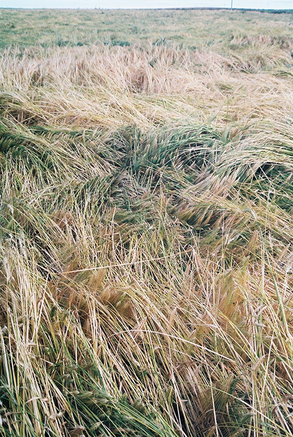
Bere is tall, its length of four to five feet the obvious reason for its lodging in Orkney’s rainy climate. Bere’s tallness, just as that of Farro grains, is indicative of a root system larger than that of short-bred industrial cultivars; this bigger-roots aspect is expressed in nutritional superiority – more root, more uptake.
Beyond the field, a few miles pa the mill, lies Skara Brae, Europe’s largest neolithic village of round stone houses. Part of a UNESCO World Heritage site, Skara Brae’s astonishing preservation is due to it having been covered up until 1850, when an enormous storm uncovered it – to the amazement of the locals. Archeologists date the village at 3180 B.C. The tribe who lived here for about 600 years grew barley. Make that Bere.
Beyond the field, a few miles pa the mill, lies Skara Brae, Europe’s largest neolithic village of round stone houses. Part of a UNESCO World Heritage site, Skara Brae’s astonishing preservation is due to it having been covered up until 1850, when an enormous storm uncovered it – to the amazement of the locals. Archeologists date the village at 3180 B.C. The tribe who lived here for about 600 years grew barley. Make that Bere.
Neolithic peoples ground Bere with saddle querns; Bronze Age had trough querns; rotary querns stem from the Iron Age and were still in use locally in the early 1900s. Which brings us back to Barony Mills where we find Johnston telling the tour group to have a go at the rotary quern on display. The simplicity of hand-milling a little Bere delights the visitors.
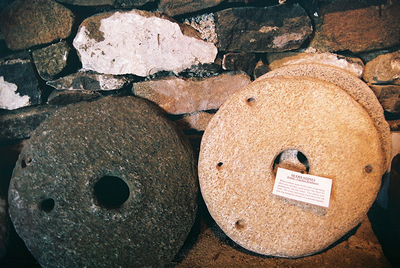
If Johnston was originally hired as guide, he’s now a miller, too, he relates in an interview. When Barony Mills was sold to the Orkney Island Council in 1992, the operation of the mill was turned over to the Birsay Heritage Trust, Birsay the parish where the mill is located. When third-generation miller Rae Phillips decided to retire, it fell to him to teach Johnston the trade.
What was it like to learn milling? “Ooh,” Johnston says, tilting his head, seeking words. “Actually, you’re learning all the time,” he tells us at last.
With machinery 138 years old, the challenge is a particular one. When we arrive early for one of the interviews, we find Johnston oil can and grease gun in hand. Lubrication is his first chore everyday, he notes, and as we watch him bend to gear, sprocket, shaft, bearing, it becomes apparent that running old equipment like this requires a relationship between man and machine that rarely exists in our computerized world.
Later, when we observe Johnston speak to yet another visitor group about flour, we realize that he’s acquired a similarly keen relationship with his product. First he demonstrates the slow use of sieves to determine if the flour has the proper structure, but then, with a quick gesture of impatience he reaches into the bag and flings a flour handful against the wooden door. Before the visitors can adjust their facial expressions, Johnston points to the revelation on the door: “You see how it sticks. If the flour is too fine, or too coarse, it won’t stick.”
Ah, yes, working relationships: the way Johnston holds Bere samples in his hands lets us see the grain in its hull, and the grain shelled out, and we also sense the subtext – this man loves his medium.
A high point of the tour comes when Johnston invites one of the visitors to start the mill. A large wooden lever pulls open the gate channeling the water over the tall waterwheel outside, but first we must guess. “How many gallons of water an hour do you think it takes to run this mill?”
“Forty gallons,” one visitor ventures.
“Four hundred.”
“Ten thousand.”
There is a collective gasp when Johnston gives up the number – 110,000 gallons an hour turn the huge wheel at 12 rotations per minute. Heavy shafts and gears transfer the water power so the big millstones turn at 120 rpm.
“Three stones do the milling,” Johnston explains while we’re still gathered by the lever. First the cups of an open elevator lift the grain up to the third story where the Bere flows over a fanning mill that removes straw and fines, and then flows through a de-stoner that removes little rocks the combine might have picked up; then, the first set of millstones, the bottom one stationary, the top one turning, shell the hull off, they’re called are the shilling stones. The second and third sets of stones grind the Bere first coarsely, then finer.
Those stones possess a gravitas also no longer of this world. Some came all the way from south of Paris, France weighing 1 1/2 tons apiece. They’re quartz stone, only two steps of hardness below diamond. For Johnston, they serve as an example of life in 1873. “How do you think these stones got here?,” he asks, and then launches into the drama of six men and a horse struggling to roll each stone cross-country, the horse in front on level and upward sloping ground, but behind the rolling stone on dangerous downhill.
What was it like to learn milling? “Ooh,” Johnston says, tilting his head, seeking words. “Actually, you’re learning all the time,” he tells us at last.
With machinery 138 years old, the challenge is a particular one. When we arrive early for one of the interviews, we find Johnston oil can and grease gun in hand. Lubrication is his first chore everyday, he notes, and as we watch him bend to gear, sprocket, shaft, bearing, it becomes apparent that running old equipment like this requires a relationship between man and machine that rarely exists in our computerized world.
Later, when we observe Johnston speak to yet another visitor group about flour, we realize that he’s acquired a similarly keen relationship with his product. First he demonstrates the slow use of sieves to determine if the flour has the proper structure, but then, with a quick gesture of impatience he reaches into the bag and flings a flour handful against the wooden door. Before the visitors can adjust their facial expressions, Johnston points to the revelation on the door: “You see how it sticks. If the flour is too fine, or too coarse, it won’t stick.”
Ah, yes, working relationships: the way Johnston holds Bere samples in his hands lets us see the grain in its hull, and the grain shelled out, and we also sense the subtext – this man loves his medium.
A high point of the tour comes when Johnston invites one of the visitors to start the mill. A large wooden lever pulls open the gate channeling the water over the tall waterwheel outside, but first we must guess. “How many gallons of water an hour do you think it takes to run this mill?”
“Forty gallons,” one visitor ventures.
“Four hundred.”
“Ten thousand.”
There is a collective gasp when Johnston gives up the number – 110,000 gallons an hour turn the huge wheel at 12 rotations per minute. Heavy shafts and gears transfer the water power so the big millstones turn at 120 rpm.
“Three stones do the milling,” Johnston explains while we’re still gathered by the lever. First the cups of an open elevator lift the grain up to the third story where the Bere flows over a fanning mill that removes straw and fines, and then flows through a de-stoner that removes little rocks the combine might have picked up; then, the first set of millstones, the bottom one stationary, the top one turning, shell the hull off, they’re called are the shilling stones. The second and third sets of stones grind the Bere first coarsely, then finer.
Those stones possess a gravitas also no longer of this world. Some came all the way from south of Paris, France weighing 1 1/2 tons apiece. They’re quartz stone, only two steps of hardness below diamond. For Johnston, they serve as an example of life in 1873. “How do you think these stones got here?,” he asks, and then launches into the drama of six men and a horse struggling to roll each stone cross-country, the horse in front on level and upward sloping ground, but behind the rolling stone on dangerous downhill.
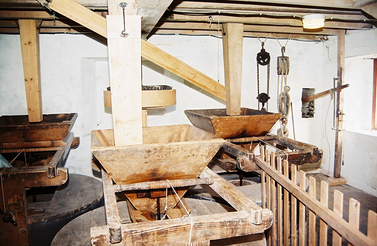
By the time he’s fleshed out the picture for us, we recognize the raconteur – not a bad trait for a guide. He even leads us down the path of social justice spurned. “It was 40 years after slavery had been abolished, but the earl forced the people here to build this mill, without paying them for their labor. And after they’d built the mill they had to pay for the milling.”
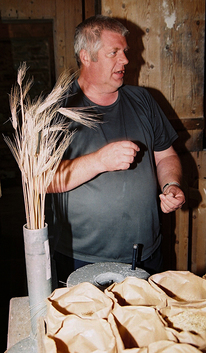
Finally a visitor gets to push the lever that opens the sluice gates; it takes a minute – everyone listening intently – before gears and stones start turning, and when they do they rumble, a rhythmic rumble parlayed to the wooden floor, echoing from the stone walls all these many years.
Bere milling results in several products. The hulls become fuel for the fire during the drying process, the Bere arriving from the field wetter than the 8 percent moisture required for milling. Then there is grap, un-sieved meal that’s mostly irregularly cracked grain which is used for livestock feed. The next grade is sieved cracked grain cereal that can be cooked as porridge. Lastly, the main product is flour that’s called beremeal. In a few places you can find the traditional beremeal bannocks to this day: “We supply some Edinburgh bakeries regularly, and just this morning I sent 19 kilograms of beremeal to a London restaurant,” Johnston remarks.
Besides bannocks, beremeal makes tasty biscuits, crackers and, usually blended with other flour, hardy breads.
Johnston noted that the milling months at Barony are October to March, when the harvest from their contracted Bere field is transformed to around 11 tons of flour. In addition, Johnston mills some of the local wheat, a Finnish variety called Annina, and also Finnish Fiia oats that, in contrast to American soft oats, “are extremely hard grain.”
At the mill you can buy beremeal for £2..50 per 1.5 kilogram sack (around $1.30 a pound). That’s a fairly steep retail price reflecting the comparably low yields of Bere, Johnston acknowledges. But you get what you pay for – with Bere you enjoy a unique Scottish flavor in a food with much better nutrition than that of cheap wheat.
Bere milling results in several products. The hulls become fuel for the fire during the drying process, the Bere arriving from the field wetter than the 8 percent moisture required for milling. Then there is grap, un-sieved meal that’s mostly irregularly cracked grain which is used for livestock feed. The next grade is sieved cracked grain cereal that can be cooked as porridge. Lastly, the main product is flour that’s called beremeal. In a few places you can find the traditional beremeal bannocks to this day: “We supply some Edinburgh bakeries regularly, and just this morning I sent 19 kilograms of beremeal to a London restaurant,” Johnston remarks.
Besides bannocks, beremeal makes tasty biscuits, crackers and, usually blended with other flour, hardy breads.
Johnston noted that the milling months at Barony are October to March, when the harvest from their contracted Bere field is transformed to around 11 tons of flour. In addition, Johnston mills some of the local wheat, a Finnish variety called Annina, and also Finnish Fiia oats that, in contrast to American soft oats, “are extremely hard grain.”
At the mill you can buy beremeal for £2..50 per 1.5 kilogram sack (around $1.30 a pound). That’s a fairly steep retail price reflecting the comparably low yields of Bere, Johnston acknowledges. But you get what you pay for – with Bere you enjoy a unique Scottish flavor in a food with much better nutrition than that of cheap wheat.
*****
If the Bere at Barony Mills is primarily raised for historical authenticity, the Agronomy College at Orkney College, Kirkwall views the crop as an opportunity for farmers, at least potentially, we’re told by department head Peter Martin who holds a PhD in agronomy.
A branch of the University of the Highlands and Islands, the college at Kirkland is investigating early-maturing cereal grain varieties in general, particularly cultivars from Scandinavia, Martin noted. “They are better suited to our climate than UK (United Kingdom) varieties.”
Also, the search is on for a modern malting barley that would perform well under Orkney conditions, he said, “so that Highland Park Distillery can produce an ‘All-Orkney Whisky’.” The college will help a group of local growers supply the distillery, he adds.
On their Bere project, the college together with several cooperating growers raises between 40 and 50 acres of Bere a year. “In Britain, most barley produced are are two-row varieties, although Scandinavia tends to grow more six-row varieties.”
What with the ancient history of Bere across Britain, it seems likely that more than one land-race Bere would exist, but that’s not the case, Martin says. “The Bere that’s still grown in Shetland, Orkney and the Western Isles is considered one landrace. Although, they’re probably three populations if you go down to the level of genetic markers,” he notes, adding that in their appearance there are no differences.
Unlike Spelt, Emmer, Einkorn that are recognized as genotypes very different than wheats, Bere has to do with Hordeum vulgare as all the other barleys. That’s despite the fact that Bere is distinguished by physical differences. “Bere is botanically different from barley; when you look at the individual barley grain you notice it has a groove, with Bere there are microscopic hairs in that groove that you don’t see in barleys,” Martin says.
Landrace crops often rank as particularly hardy types, and that goes for Bere. Yet for farming it on Orkney, its fast-maturing aspect is the most important, Martin emphasizes: Orkney is a fertile land that can grow a huge variety of grains, even Emmer grew well here in some of their plots. It’s not the growing that’s the problem, but the harvest timing. The island fields don’t dry out enough to be worked for planting until April, and by September it’s often touch-and-go to get the grain stands harvested before the fields once again become too soggy for farm machinery.
How much water falls on Orkney? “Around 1000 millimeters.” You can round that off and call it a yard, a yard of water in 12 months. That’s wet alright.
Martin says that their Bere research indicates an optimal seeding rate of 160 kilograms per hectare (about 140 pounds per acre). Yields are relatively short: “Between 3 1/2 and 4 tons per hectare, compared to modern barley yields around 6 tons per hectare here” (about 1.4 to 1.6 tons per acre, 2.3 tons respectively).
The college seeks to improve yields through farm practices, he remarked. One approach some growers are taking is to apply growth regulator, to reduce the lodging of the fields. “But I’m not altogether convinced that it works,” Martin says.
The potential for the crop of course lies in promotion and marketing of Bere as a specialty food. “Bere will always be a higher value product.” Whereas individual bakeries such as Argos on Orkney report good customer interest in Bere products, Martin acknowledges that it’ll take serious interest from bigger players for bere to make a comeback on a larger scale. “The logic behind promoting Bere is that it’s Scotland Bere. If larger companies pick up on that, yes, I can see growth in new markets.”
It won’t be too long before we’ll find out if Martin’s hunch pays out, since much of the last few Orkney Bere crops were shipped to Islay, an island on Scotland’s west coast: “A distillery there is using the Bere to make true Scotch Whisky. Because whisky has to age for years, the product is not on the market yet.”
A branch of the University of the Highlands and Islands, the college at Kirkland is investigating early-maturing cereal grain varieties in general, particularly cultivars from Scandinavia, Martin noted. “They are better suited to our climate than UK (United Kingdom) varieties.”
Also, the search is on for a modern malting barley that would perform well under Orkney conditions, he said, “so that Highland Park Distillery can produce an ‘All-Orkney Whisky’.” The college will help a group of local growers supply the distillery, he adds.
On their Bere project, the college together with several cooperating growers raises between 40 and 50 acres of Bere a year. “In Britain, most barley produced are are two-row varieties, although Scandinavia tends to grow more six-row varieties.”
What with the ancient history of Bere across Britain, it seems likely that more than one land-race Bere would exist, but that’s not the case, Martin says. “The Bere that’s still grown in Shetland, Orkney and the Western Isles is considered one landrace. Although, they’re probably three populations if you go down to the level of genetic markers,” he notes, adding that in their appearance there are no differences.
Unlike Spelt, Emmer, Einkorn that are recognized as genotypes very different than wheats, Bere has to do with Hordeum vulgare as all the other barleys. That’s despite the fact that Bere is distinguished by physical differences. “Bere is botanically different from barley; when you look at the individual barley grain you notice it has a groove, with Bere there are microscopic hairs in that groove that you don’t see in barleys,” Martin says.
Landrace crops often rank as particularly hardy types, and that goes for Bere. Yet for farming it on Orkney, its fast-maturing aspect is the most important, Martin emphasizes: Orkney is a fertile land that can grow a huge variety of grains, even Emmer grew well here in some of their plots. It’s not the growing that’s the problem, but the harvest timing. The island fields don’t dry out enough to be worked for planting until April, and by September it’s often touch-and-go to get the grain stands harvested before the fields once again become too soggy for farm machinery.
How much water falls on Orkney? “Around 1000 millimeters.” You can round that off and call it a yard, a yard of water in 12 months. That’s wet alright.
Martin says that their Bere research indicates an optimal seeding rate of 160 kilograms per hectare (about 140 pounds per acre). Yields are relatively short: “Between 3 1/2 and 4 tons per hectare, compared to modern barley yields around 6 tons per hectare here” (about 1.4 to 1.6 tons per acre, 2.3 tons respectively).
The college seeks to improve yields through farm practices, he remarked. One approach some growers are taking is to apply growth regulator, to reduce the lodging of the fields. “But I’m not altogether convinced that it works,” Martin says.
The potential for the crop of course lies in promotion and marketing of Bere as a specialty food. “Bere will always be a higher value product.” Whereas individual bakeries such as Argos on Orkney report good customer interest in Bere products, Martin acknowledges that it’ll take serious interest from bigger players for bere to make a comeback on a larger scale. “The logic behind promoting Bere is that it’s Scotland Bere. If larger companies pick up on that, yes, I can see growth in new markets.”
It won’t be too long before we’ll find out if Martin’s hunch pays out, since much of the last few Orkney Bere crops were shipped to Islay, an island on Scotland’s west coast: “A distillery there is using the Bere to make true Scotch Whisky. Because whisky has to age for years, the product is not on the market yet.”
*****
The resurgence of Bere in Scotland is occurring slightly after the appearance of two hulless barleys on the natural foods scene of America’s Pacific Northwest.
Hulless, of course, means the absence of that cement-like substance between hull and kernel that defines hulled barleys; on hulless barleys the hull can be removed by impact dehulling, thus all the bran and the germ stays intact – the berries of hulless barley are truly whole-grain. In America’s kitchens that makes for a new barley experience.
And, these particular hulless barleys stand out by their color purple, one of them so dark a purple that the bran looks black.
Hulless, of course, means the absence of that cement-like substance between hull and kernel that defines hulled barleys; on hulless barleys the hull can be removed by impact dehulling, thus all the bran and the germ stays intact – the berries of hulless barley are truly whole-grain. In America’s kitchens that makes for a new barley experience.
And, these particular hulless barleys stand out by their color purple, one of them so dark a purple that the bran looks black.
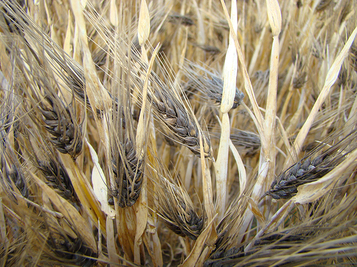
The story of this black barley reappearance is a round-about one. Two researchers at Montana State University had been given the task to find specific barley traits suited for the development of industrial compounds. In that context they received a variety of germ plasm from the USDA, including some ancient genotypes. When they grew out the land-races they noticed color in their plots.
Colored grain was not what the scientists were after in their industrial project, but it occurred to them that this black and purple grain might fit into another context: health food.
How did we arrive at the current demand for strong color of foods?, after all those many decades of whiter-is-better in white bread, white rice, white-blond noodles, white mashed potatoes?
Chalk it up to the French. They weren’t dying from heart disease at the same high rate as Americans were, despite a diet rather high in fatty acids. This intrigued the scientific community. What could it be in the French diet that made them so healthy?
They pop corks, that’s what does it, the research revealed. Pulling the cork from a bottle of Beaujolais, Burgundy, or Bordeaux, at meal times, not only heralds a pleasant flavor complement to fowl and pork and beef, it also promises a pleasurable pace of dining – you don’t hurry through a meal when sharing a bottle of fine wine, do you.
But those were not the findings of the scientists. Instead, they identified a polyphenol compound in the red grape as the health giver: resveratrol. An antioxidant.
What’s curious is the reaction of the American public to the research results. We are bombarded at every turn, it seems, with new, new, nutritional information. As Michael Pollan pointed out, we’re the only animal that frets about what to eat, what not to eat. A new Diet pops up monthly. Who bothers keeping track of what’s good for you, this month? Yet the resveratrol findings, and further research of antioxidants, resonated. Perhaps because the science can be reduced to a very simple summation – plant pigments contain good stuff for you.
Blue potatoes. Purple carrots. Purple cabbage. Don’t peel that red apple skin. Eat your beets.
Black rice.
Black barley: its antioxidant is the flavonoid anthocyanin.
Colored grain was not what the scientists were after in their industrial project, but it occurred to them that this black and purple grain might fit into another context: health food.
How did we arrive at the current demand for strong color of foods?, after all those many decades of whiter-is-better in white bread, white rice, white-blond noodles, white mashed potatoes?
Chalk it up to the French. They weren’t dying from heart disease at the same high rate as Americans were, despite a diet rather high in fatty acids. This intrigued the scientific community. What could it be in the French diet that made them so healthy?
They pop corks, that’s what does it, the research revealed. Pulling the cork from a bottle of Beaujolais, Burgundy, or Bordeaux, at meal times, not only heralds a pleasant flavor complement to fowl and pork and beef, it also promises a pleasurable pace of dining – you don’t hurry through a meal when sharing a bottle of fine wine, do you.
But those were not the findings of the scientists. Instead, they identified a polyphenol compound in the red grape as the health giver: resveratrol. An antioxidant.
What’s curious is the reaction of the American public to the research results. We are bombarded at every turn, it seems, with new, new, nutritional information. As Michael Pollan pointed out, we’re the only animal that frets about what to eat, what not to eat. A new Diet pops up monthly. Who bothers keeping track of what’s good for you, this month? Yet the resveratrol findings, and further research of antioxidants, resonated. Perhaps because the science can be reduced to a very simple summation – plant pigments contain good stuff for you.
Blue potatoes. Purple carrots. Purple cabbage. Don’t peel that red apple skin. Eat your beets.
Black rice.
Black barley: its antioxidant is the flavonoid anthocyanin.
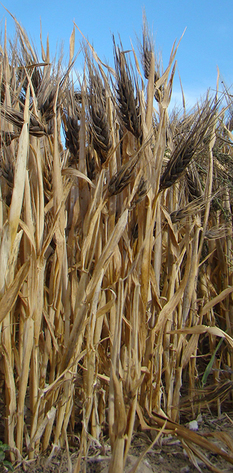
Our Montana researchers took some of the colored barleys home for a seed increase on the side. A Montana company specializing in Timeless Seeds ended up with their seed stock. A few years later the black barley landed at Lentz Spelt Farms on the Columbia Plateau. In view of its genetic connection to Egypt’s barley history, Black Nile Barley was chosen for the genotype name.
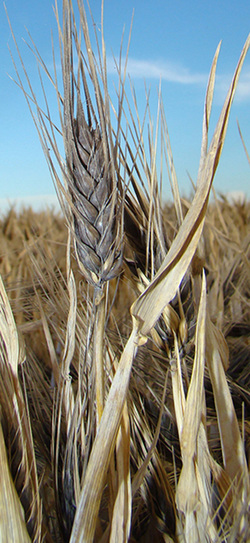
Black Nile Barley appeals to the chef. Full-bodied when prepared in risotto-type dishes, flavorful in hearty soups, Black Nile Barley fulfills its promise of nutritional rectitude. A stand-up starch component to make any meal proud. A visual surprise on the dinner plate.
Bakers like the Black Nile Barley because it adds dimension to the world of muffin and cupcake, tea cake and sweet bun. And, that scrumptious relative of the Scottish bannock, the scone, couldn’t call for a better flour.
Before Black Nile Barley was introduced to Washington organic agriculture, several bakers tested the flour. One of these bakers likes to begin his tests of a new-type flour not by way of oven cake but by pancake, as a very direct way to let the palate explore the flavor profile: “The best pancakes I ever had,” he said about the Black Nile Barley.
One stop of barley’s long journey was Rome’s Colosseum. The gladiators there were sometimes called barley-eaters, hordearii. Perhaps their image comes to mind when you enjoy the resurgent grain. Or you simply look out the kitchen window into a gray November day. You’re ready for that now.
And while you’re putting on your boots, here a last historical barley tidbit: American shoe sizes originated as measures in barleycorn.
Bakers like the Black Nile Barley because it adds dimension to the world of muffin and cupcake, tea cake and sweet bun. And, that scrumptious relative of the Scottish bannock, the scone, couldn’t call for a better flour.
Before Black Nile Barley was introduced to Washington organic agriculture, several bakers tested the flour. One of these bakers likes to begin his tests of a new-type flour not by way of oven cake but by pancake, as a very direct way to let the palate explore the flavor profile: “The best pancakes I ever had,” he said about the Black Nile Barley.
One stop of barley’s long journey was Rome’s Colosseum. The gladiators there were sometimes called barley-eaters, hordearii. Perhaps their image comes to mind when you enjoy the resurgent grain. Or you simply look out the kitchen window into a gray November day. You’re ready for that now.
And while you’re putting on your boots, here a last historical barley tidbit: American shoe sizes originated as measures in barleycorn.
© 2013 Lentz Spelt Farms



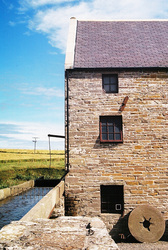
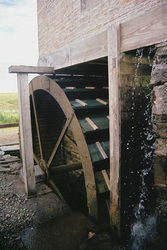

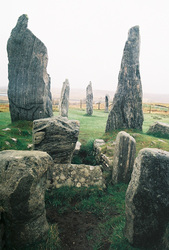
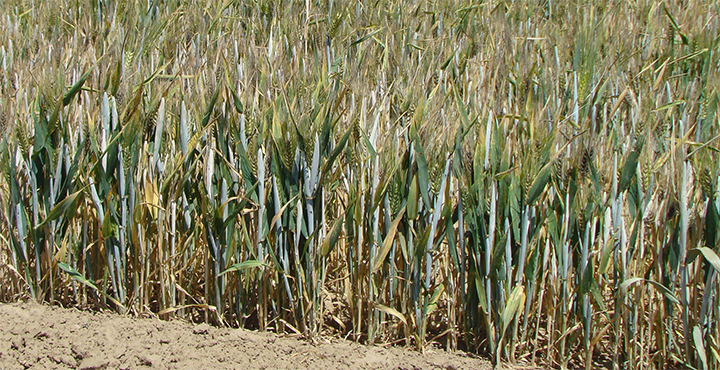
 RSS Feed
RSS Feed